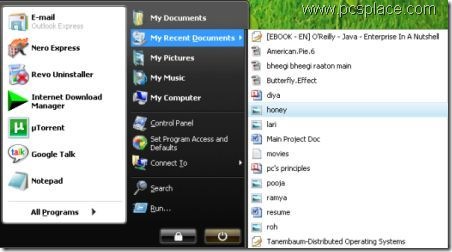The document history in the Start menu is actually quite practical as one can quickly open the last edited files with the appropriate program and continue working on them, theoretically that is. In practice, however, the list of My Recent Documents is filled with irrelevant entries.
You can get rid of useless files or file formats. Thus you will find it easier to identify the more important entries in the list and it saves a lot of time. In the registry, you can not only determine the display and number of elements in the history but also define many further properties for each file type using the “Edit Flags” entry in the list for instance.

For this,
-
Open “Run” in the Start menu, enter “regedit” and click “OK”.
-
If, for instance, you do not want MP3 files to appear in the history, navigate to the “HKEY_CLASSES_ROOT\.mp3” key.
-
There are separate keys with the respective extensions for other file types.
-
Read the value of the “Standard” character string, “mp3fle” in the example, for the corresponding file type.
-
The next step is to navigate to the key of the respective file type, i.e., to “HKEY_CLASSES_ROOT\mp3fle”.
-
Now look for the “Edit Flags” entry of the type “DWORD” or “BINARY” on the right.
-
If it does not exist, create it with “Edit > New > DWORD value”.
-
Double-click on it and it will open.
-
Here “Base” must be set as “Hexadecimal”. Then enter the value “00100000” and click “OK”.
If the value already exists, you have to link it with the “logical OR” hex value otherwise, you will change other predefined properties. This is because each Bit in the hex value defines a different property. The following procedure changes depending on whether the existing value is of the “DWORD” or “BINARY” type.
Here is how to calculate Dword and Binary values..
DWORD VALUE:
The Windows calculator comes in handy when linking the value.
-
Switch to the professional mode by clicking “View > Scientific" and select the “Hex” option.
-
In the input field, enter the value from the registry, click “Or” and then type “100000”.
Important: the leading zeroes are not taken into account! A click on “=” shows the new value. Double-click “Edit Flags” in the registry.
-
Overwrite the value with the result in the calculator and confirm with “OK”.
BINARY VALUE:
Unlike DWORD values, a different Bit sequence is valid for “BINARY”. This is why you should use the value “00 00 10 00” for the “Or” function.
Example: the existing value for “mp3fle” is “00 00 01 00”. In the Windows calculator, select “Bin”, type “100”, and then press “Or” and type “1000”. A click on “=” shows the result: “1100”. See to it that you don’t insert additional bytes when making entries in the registry. Confirm with “OK” and close the registry.
You can use the same method to decide whether other file types such as videos or graphics should appear in the document history or not.
